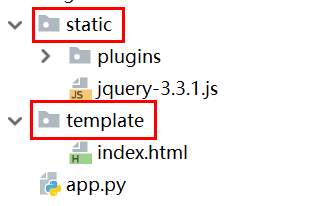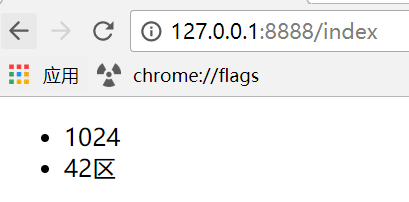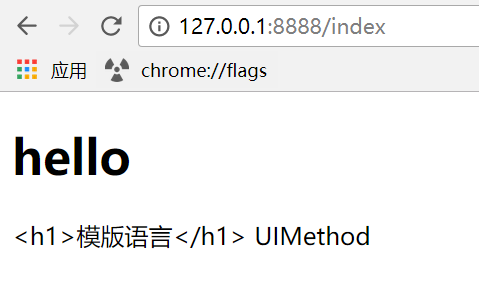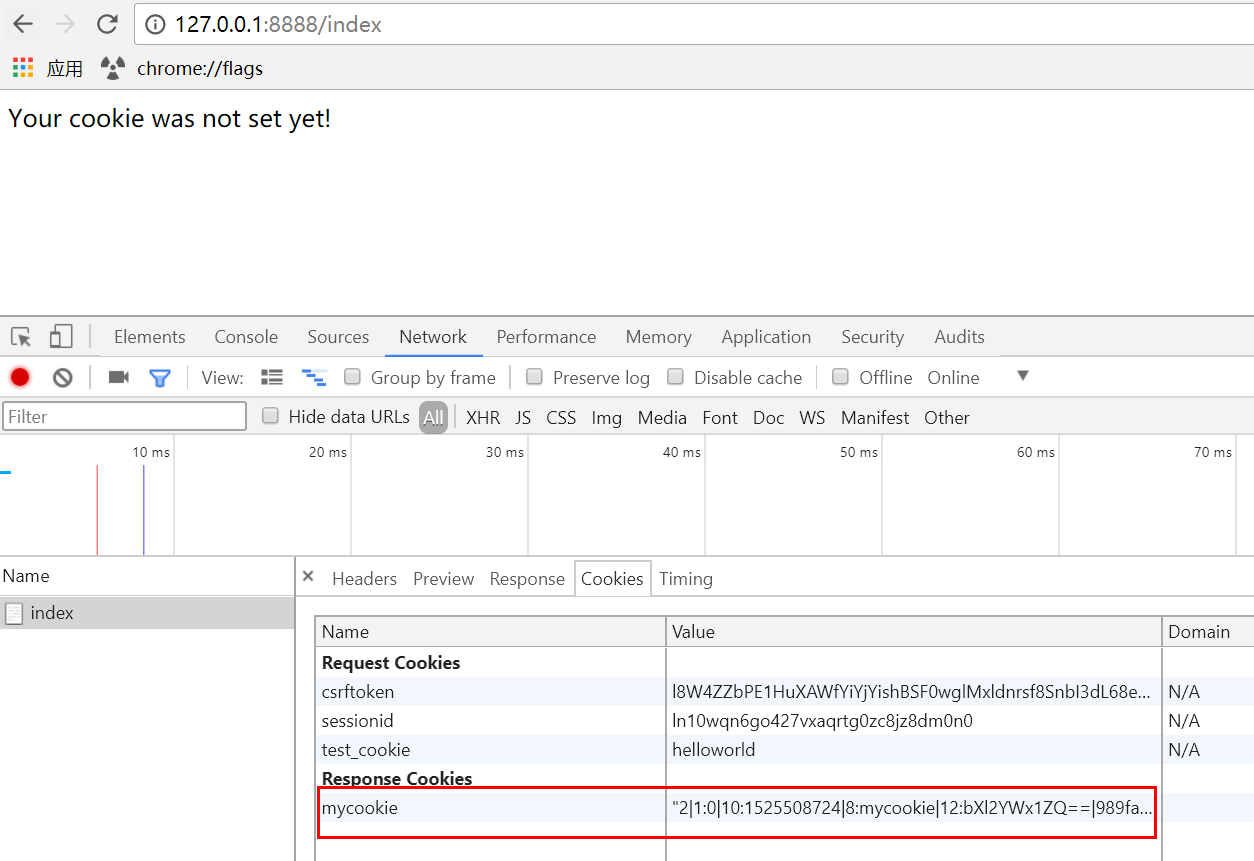Tornado之笔记集合
目录
一、基本使用
1、最简使用
import tornado.ioloop
import tornado.web class MainHandler(tornado.web.RequestHandler):
def get(self):
self.write("Hello, world") application = tornado.web.Application([
(r"/index", MainHandler),
]) if __name__ == "__main__":
application.listen(8888)
tornado.ioloop.IOLoop.instance().start()
app.py示例

2、settings
settings = {
'template_path': 'template', # html文件夹
'static_path': 'static', # 静态文件夹
'static_url_prefix': '/static/', # html里的静态文件夹路径前缀
'ui_methods': mt,
'ui_modules': md,
}
application = tornado.web.Application([
(r"/index", MainHandler),
], **settings) # 在这使用**settings

(1)html里静态文件使用方法
建议用这种
<link href="{{static_url("css/common.css")}}" rel="stylesheet" /> <script src="{{static_url("jquery-3.3.1.js")}}"></script> 或 <link href="/static/css/common.css" rel="stylesheet" /> <script src="/static/jquery-3.3.1.js"></script>
静态文件缓存的实现(这段不知道是什么,先记录下来)
def get_content_version(cls, abspath):
"""Returns a version string for the resource at the given path. This class method may be overridden by subclasses. The
default implementation is a hash of the file's contents. .. versionadded:: 3.1
"""
data = cls.get_content(abspath)
hasher = hashlib.md5()
if isinstance(data, bytes):
hasher.update(data)
else:
for chunk in data:
hasher.update(chunk)
return hasher.hexdigest()
静态文件缓存的实现
路由系统
1、基本使用
路由系统其实就是 url 和 类 的对应关系,这里不同于其他框架,其他很多框架均是 url 对应 函数,Tornado中每个url对应的是一个类
class MainHandler(tornado.web.RequestHandler):
def get(self):
self.write("Hello, world") application = tornado.web.Application([
(r"/index", MainHandler),
(r"/story/([0-9]+)", StoryHandler),
])
import tornado.ioloop
import tornado.web class MainHandler(tornado.web.RequestHandler):
def get(self):
self.write("Hello, world") class StoryHandler(tornado.web.RequestHandler):
def get(self, story_id):
self.write("You requested the story " + story_id) class BuyHandler(tornado.web.RequestHandler):
def get(self):
self.write("buy.wupeiqi.com/index") application = tornado.web.Application([
(r"/index", MainHandler),
(r"/story/([0-9]+)", StoryHandler),
]) application.add_handlers('buy.wupeiqi.com$', [
(r'/index',BuyHandler),
]) if __name__ == "__main__":
application.listen(80)
tornado.ioloop.IOLoop.instance().start()
示例
2、其他
reverse_url
#!/usr/bin/env python
# -*- coding:utf-8 -*- import tornado.ioloop
import tornado.web
from tornado.web import RequestHandler class MainHandler(RequestHandler):
def get(self):
url1 = self.application.reverse_url("n1")
print(url1)
url2 = self.application.reverse_url("n2",666)
print(url2)
self.write("Hello, world") class HomeHandler(RequestHandler):
def get(self,*args,**kwargs):
print(args)
print(kwargs)
self.write("welcome home") application = tornado.web.Application([
(r"/index", MainHandler,{},"n1"),
(r"/home/(?P<pk>\d+)", HomeHandler,{},"n2"),
]) if __name__ == "__main__":
application.listen(8888)
tornado.ioloop.IOLoop.instance().start() '''
/index
/home/666
'''
app.py
视图函数
模版语言
1、基本使用
#!/usr/bin/env python
# -*- coding:utf-8 -*- import tornado.ioloop
import tornado.web class MainHandler(tornado.web.RequestHandler):
def get(self):
self.render("index.html", list_info = [11,22,33]) application = tornado.web.Application([
(r"/index", MainHandler),
]) if __name__ == "__main__":
application.listen(8888)
tornado.ioloop.IOLoop.instance().start()
app.py
<!DOCTYPE html>
<html>
<head>
<meta http-equiv="Content-Type" content="text/html; charset=UTF-8"/>
</head>
<body> <div>
<ul>
{% for item in list_info %}
<li>{{item}}</li>
{% end %}
</ul>
</div> </body>
</html>
index.html
在模板中默认提供了一些函数、字段、类以供模板使用: escape: tornado.escape.xhtml_escape 的別名
xhtml_escape: tornado.escape.xhtml_escape 的別名
url_escape: tornado.escape.url_escape 的別名
json_encode: tornado.escape.json_encode 的別名
squeeze: tornado.escape.squeeze 的別名
linkify: tornado.escape.linkify 的別名
datetime: Python 的 datetime 模组
handler: 当前的 RequestHandler 对象
request: handler.request 的別名
current_user: handler.current_user 的別名
locale: handler.locale 的別名
_: handler.locale.translate 的別名
static_url: for handler.static_url 的別名
xsrf_form_html: handler.xsrf_form_html 的別名
其他方法

2、for、if使用
{% for item in list_info %}
<li>{{item}}</li>
{% end %}
{% if item > 22 %}
<h1>{{item}}</h1>
{% else %}
<li>{{item}}</li>
{% end %}
3、母版、插件
(1)母版
用法与django基本一致
{% extends 'xxxxxxxx.html'%}
{% block xxx %}{% end %}
<!DOCTYPE html>
<html>
<head>
<meta http-equiv="Content-Type" content="text/html; charset=UTF-8"/>
<title>老男孩</title>
{% block CSS %}{% end %}
</head>
<body> <div class="pg-header"> </div> {% block RenderBody %}{% end %} {% block JavaScript %}{% end %}
</body>
</html>
layout.html
{% extends 'layout.html'%}
{% block CSS %}
{% end %}
{% block RenderBody %}
<h1>Index</h1>
<ul>
{% for item in list_info %}
<li>{{item}}</li>
{% end %}
</ul>
{% end %}
{% block JavaScript %}
{% end %}
index.html

(2)插件
用法与django基本一致
{% include 'xxxxx.html' %}
<div>
<ul>
<li>1024</li>
<li>42区</li>
</ul>
</div>
header.html
<!DOCTYPE html>
<html>
<head>
<meta http-equiv="Content-Type" content="text/html; charset=UTF-8"/>
</head>
<body>
<div class="pg-header">
{% include 'header.html' %}
</div>
</body>
</html>
index.html

4、自定义UIMethod、UIModule
类似于django的simply_tag
(1)自定义uimethods.py与uimodules.py。注意:这里的uimethods和uimodules只是py的文件名
def tab(self):
return 'UIMethod'
uimethods.py
#!/usr/bin/env python
# -*- coding:utf-8 -*-
from tornado.web import UIModule
from tornado import escape class custom(UIModule): def render(self, *args, **kwargs):
return escape.xhtml_escape('<h1>模版语言</h1>')
uimodules.py
(2)在主程序中注册settings
#!/usr/bin/env python
# -*- coding:utf-8 -*- import tornado.ioloop
import tornado.web
from tornado.escape import linkify
import uimodules as md # 导入自定义模块
import uimethods as mt # 导入自定义模块 class MainHandler(tornado.web.RequestHandler):
def get(self):
self.render('index.html') settings = {
'template_path': 'template', # html文件夹
'static_path': 'static', # 静态文件夹
'static_url_prefix': '/static/',
'ui_methods': mt,
'ui_modules': md,
} application = tornado.web.Application([
(r"/index", MainHandler),
], **settings) if __name__ == "__main__":
application.listen(8888)
tornado.ioloop.IOLoop.instance().start()
app.py
(3)在html上使用
<!DOCTYPE html>
<html>
<head lang="en">
<meta charset="UTF-8">
<title></title>
<link href="{{static_url("commons.css")}}" rel="stylesheet" />
</head>
<body>
<h1>hello</h1>
{% module custom(123) %}
{{ tab() }}
</body>
index.html

cookie
self.set_cookie("mycookie", "myvalue")
self.get_cookie("xxx")
self.set_secure_cookie("mycookie", "myvalue")
self.get_secure_cookie("xxx")
expires使用时间戳
import time
expire_time = time.time() + 300 # 时间戳
self.set_cookie("mycookie","myvalue",expires=expire_time)
1、基本使用
import tornado.ioloop
import tornado.web class MainHandler(tornado.web.RequestHandler):
def get(self):
self.set_cookie('test_cookie',"helloworld")
self.write("Hello, world") application = tornado.web.Application([
(r"/index", MainHandler),
]) if __name__ == "__main__":
application.listen(8888)
tornado.ioloop.IOLoop.instance().start()
app.py

2、加密cookie(签名)
Cookie 很容易被恶意的客户端伪造。加入你想在 cookie 中保存当前登陆用户的 id 之类的信息,你需要对 cookie 作签名以防止伪造。Tornado 通过 set_secure_cookie 和 get_secure_cookie 方法直接支持了这种功能。 要使用这些方法,你需要在创建应用时提供一个密钥,名字为 cookie_secret。 你可以把它作为一个关键词参数传入应用的设置中。
签名cookie的本质:
写cookie过程: 将值进行base64加密
对除值以外的内容进行签名,哈希算法(无法逆向解析)
拼接 签名 + 加密值
读cookie过程: 读取 签名 + 加密值
对签名进行验证
base64解密,获取值内容
import tornado.ioloop
import tornado.web class MainHandler(tornado.web.RequestHandler):
def get(self):
if not self.get_secure_cookie("mycookie"):
self.set_secure_cookie("mycookie", "myvalue")
self.write("Your cookie was not set yet!")
else:
self.write("Your cookie was set!") application = tornado.web.Application([
(r"/index", MainHandler),
], cookie_secret="61oETzKXQAGaYdkL5gEmGeJJFuYh7EQnp2XdTP1o/Vo=") if __name__ == "__main__":
application.listen(8888)
tornado.ioloop.IOLoop.instance().start()
app.py
def _create_signature_v1(secret, *parts):
hash = hmac.new(utf8(secret), digestmod=hashlib.sha1)
for part in parts:
hash.update(utf8(part))
return utf8(hash.hexdigest()) # 加密
def _create_signature_v2(secret, s):
hash = hmac.new(utf8(secret), digestmod=hashlib.sha256)
hash.update(utf8(s))
return utf8(hash.hexdigest()) def create_signed_value(secret, name, value, version=None, clock=None,
key_version=None):
if version is None:
version = DEFAULT_SIGNED_VALUE_VERSION
if clock is None:
clock = time.time timestamp = utf8(str(int(clock())))
value = base64.b64encode(utf8(value))
if version == 1:
signature = _create_signature_v1(secret, name, value, timestamp)
value = b"|".join([value, timestamp, signature])
return value
elif version == 2:
# The v2 format consists of a version number and a series of
# length-prefixed fields "%d:%s", the last of which is a
# signature, all separated by pipes. All numbers are in
# decimal format with no leading zeros. The signature is an
# HMAC-SHA256 of the whole string up to that point, including
# the final pipe.
#
# The fields are:
# - format version (i.e. 2; no length prefix)
# - key version (integer, default is 0)
# - timestamp (integer seconds since epoch)
# - name (not encoded; assumed to be ~alphanumeric)
# - value (base64-encoded)
# - signature (hex-encoded; no length prefix)
def format_field(s):
return utf8("%d:" % len(s)) + utf8(s)
to_sign = b"|".join([
b"",
format_field(str(key_version or 0)),
format_field(timestamp),
format_field(name),
format_field(value),
b'']) if isinstance(secret, dict):
assert key_version is not None, 'Key version must be set when sign key dict is used'
assert version >= 2, 'Version must be at least 2 for key version support'
secret = secret[key_version] signature = _create_signature_v2(secret, to_sign)
return to_sign + signature
else:
raise ValueError("Unsupported version %d" % version) # 解密
def _decode_signed_value_v1(secret, name, value, max_age_days, clock):
parts = utf8(value).split(b"|")
if len(parts) != 3:
return None
signature = _create_signature_v1(secret, name, parts[0], parts[1])
if not _time_independent_equals(parts[2], signature):
gen_log.warning("Invalid cookie signature %r", value)
return None
timestamp = int(parts[1])
if timestamp < clock() - max_age_days * 86400:
gen_log.warning("Expired cookie %r", value)
return None
if timestamp > clock() + 31 * 86400:
# _cookie_signature does not hash a delimiter between the
# parts of the cookie, so an attacker could transfer trailing
# digits from the payload to the timestamp without altering the
# signature. For backwards compatibility, sanity-check timestamp
# here instead of modifying _cookie_signature.
gen_log.warning("Cookie timestamp in future; possible tampering %r",
value)
return None
if parts[1].startswith(b""):
gen_log.warning("Tampered cookie %r", value)
return None
try:
return base64.b64decode(parts[0])
except Exception:
return None def _decode_fields_v2(value):
def _consume_field(s):
length, _, rest = s.partition(b':')
n = int(length)
field_value = rest[:n]
# In python 3, indexing bytes returns small integers; we must
# use a slice to get a byte string as in python 2.
if rest[n:n + 1] != b'|':
raise ValueError("malformed v2 signed value field")
rest = rest[n + 1:]
return field_value, rest rest = value[2:] # remove version number
key_version, rest = _consume_field(rest)
timestamp, rest = _consume_field(rest)
name_field, rest = _consume_field(rest)
value_field, passed_sig = _consume_field(rest)
return int(key_version), timestamp, name_field, value_field, passed_sig def _decode_signed_value_v2(secret, name, value, max_age_days, clock):
try:
key_version, timestamp, name_field, value_field, passed_sig = _decode_fields_v2(value)
except ValueError:
return None
signed_string = value[:-len(passed_sig)] if isinstance(secret, dict):
try:
secret = secret[key_version]
except KeyError:
return None expected_sig = _create_signature_v2(secret, signed_string)
if not _time_independent_equals(passed_sig, expected_sig):
return None
if name_field != utf8(name):
return None
timestamp = int(timestamp)
if timestamp < clock() - max_age_days * 86400:
# The signature has expired.
return None
try:
return base64.b64decode(value_field)
except Exception:
return None def get_signature_key_version(value):
value = utf8(value)
version = _get_version(value)
if version < 2:
return None
try:
key_version, _, _, _, _ = _decode_fields_v2(value)
except ValueError:
return None return key_version 内部算法
内部算法

CSRF
Tornado中的跨站请求伪造和Django中的相似
(Ajax使用时,本质上就是去获取本地的cookie,携带cookie再来发送请求)
settings = {
"xsrf_cookies": True,
}
application = tornado.web.Application([
(r"/", MainHandler),
(r"/login", LoginHandler),
], **settings)
app.py
<form action="/new_message" method="post">
{{ xsrf_form_html() }}
<input type="text" name="message"/>
<input type="submit" value="Post"/>
</form>
html使用form表单post
function getCookie(name) {
var r = document.cookie.match("\\b" + name + "=([^;]*)\\b");
return r ? r[1] : undefined;
}
jQuery.postJSON = function(url, args, callback) {
args._xsrf = getCookie("_xsrf");
$.ajax({url: url, data: $.param(args), dataType: "text", type: "POST",
success: function(response) {
callback(eval("(" + response + ")"));
}});
};
AJAX
文件上传
1、Form表单上传
<!DOCTYPE html>
<html>
<head>
<meta http-equiv="Content-Type" content="text/html; charset=UTF-8"/>
<title>上传文件</title>
</head>
<body>
<form id="my_form" name="form" action="/index" method="POST" enctype="multipart/form-data" >
<input name="fff" id="my_file" type="file" />
<input type="submit" value="提交" />
</form>
</body>
</html>
html
#!/usr/bin/env python
# -*- coding:utf-8 -*- import tornado.ioloop
import tornado.web class MainHandler(tornado.web.RequestHandler):
def get(self): self.render('index.html') def post(self, *args, **kwargs):
file_metas = self.request.files["fff"]
# print(file_metas)
for meta in file_metas:
file_name = meta['filename']
with open(file_name,'wb') as up:
up.write(meta['body']) settings = {
'template_path': 'template',
} application = tornado.web.Application([
(r"/index", MainHandler),
], **settings) if __name__ == "__main__":
application.listen(8000)
tornado.ioloop.IOLoop.instance().start() Python
app.py
2、AJAX上传
<!DOCTYPE html>
<html>
<head lang="en">
<meta charset="UTF-8">
<title></title>
</head>
<body>
<input type="file" id="img" />
<input type="button" onclick="UploadFile();" />
<script>
function UploadFile(){
var fileObj = document.getElementById("img").files[0]; var form = new FormData();
form.append("k1", "v1");
form.append("fff", fileObj); var xhr = new XMLHttpRequest();
xhr.open("post", '/index', true);
xhr.send(form);
}
</script>
</body>
</html>
HTML - XMLHttpRequest
<!DOCTYPE html>
<html>
<head lang="en">
<meta charset="UTF-8">
<title></title>
</head>
<body>
<input type="file" id="img" />
<input type="button" onclick="UploadFile();" />
<script>
function UploadFile(){
var fileObj = $("#img")[0].files[0];
var form = new FormData();
form.append("k1", "v1");
form.append("fff", fileObj); $.ajax({
type:'POST',
url: '/index',
data: form,
processData: false, // tell jQuery not to process the data
contentType: false, // tell jQuery not to set contentType
success: function(arg){
console.log(arg);
}
})
}
</script>
</body>
</html>
HTML - jQuery
<!DOCTYPE html>
<html>
<head lang="en">
<meta charset="UTF-8">
<title></title>
</head>
<body>
<form id="my_form" name="form" action="/index" method="POST" enctype="multipart/form-data" >
<div id="main">
<input name="fff" id="my_file" type="file" />
<input type="button" name="action" value="Upload" onclick="redirect()"/>
<iframe id='my_iframe' name='my_iframe' src="" class="hide"></iframe>
</div>
</form> <script>
function redirect(){
document.getElementById('my_iframe').onload = Testt;
document.getElementById('my_form').target = 'my_iframe';
document.getElementById('my_form').submit(); } function Testt(ths){
var t = $("#my_iframe").contents().find("body").text();
console.log(t);
}
</script>
</body>
</html>
HTML - iframe
#!/usr/bin/env python
# -*- coding:utf-8 -*- import tornado.ioloop
import tornado.web class MainHandler(tornado.web.RequestHandler):
def get(self): self.render('index.html') def post(self, *args, **kwargs):
file_metas = self.request.files["fff"]
# print(file_metas)
for meta in file_metas:
file_name = meta['filename']
with open(file_name,'wb') as up:
up.write(meta['body']) settings = {
'template_path': 'template',
} application = tornado.web.Application([
(r"/index", MainHandler),
], **settings) if __name__ == "__main__":
application.listen(8000)
tornado.ioloop.IOLoop.instance().start()
app.py
验证成功,略。
<script type="text/javascript">
$(document).ready(function () {
$("#formsubmit").click(function () {
var iframe = $('<iframe name="postiframe" id="postiframe" style="display: none"></iframe>');
$("body").append(iframe);
var form = $('#theuploadform');
form.attr("action", "/upload.aspx");
form.attr("method", "post");
form.attr("encoding", "multipart/form-data");
form.attr("enctype", "multipart/form-data");
form.attr("target", "postiframe");
form.attr("file", $('#userfile').val());
form.submit();
$("#postiframe").load(function () {
iframeContents = this.contentWindow.document.body.innerHTML;
$("#textarea").html(iframeContents);
});
return false;
});
});
</script>
<form id="theuploadform">
<input id="userfile" name="userfile" size="" type="file" />
<input id="formsubmit" type="submit" value="Send File" />
</form>
<div id="textarea">
</div>
扩展:基于iframe实现Ajax上传示例
$('#upload_iframe').load(function(){
var iframeContents = this.contentWindow.document.body.innerText;
iframeContents = JSON.parse(iframeContents);
})
function bindChangeAvatar1() {
$('#avatarImg').change(function () {
var file_obj = $(this)[0].files[0];
$('#prevViewImg')[0].src = window.URL.createObjectURL(file_obj)
})
}
function bindChangeAvatar2() {
$('#avatarImg').change(function () {
var file_obj = $(this)[0].files[0];
var reader = new FileReader();
reader.readAsDataURL(file_obj);
reader.onload = function (e) {
$('#previewImg')[0].src = this.result;
};
})
}
function bindChangeAvatar3() {
$('#avatarImg').change(function () {
var file_obj = $(this)[0].files[0];
var form = new FormData();
form.add('img_upload', file_obj);
$.ajax({
url: '',
data: form,
processData: false, // tell jQuery not to process the data
contentType: false, // tell jQuery not to set contentType
success: function (arg) {
}
})
})
}
function bindChangeAvatar4() {
$('#avatarImg').change(function () {
$(this).parent().submit();
$('#upload_iframe').load(function () {
var iframeContents = this.contentWindow.document.body.innerText;
iframeContents = JSON.parse(iframeContents);
if (iframeContents.status) {
$('#previewImg').attr('src', '/' + iframeContents.data);
}
})
})
}
其他
异步非阻塞
1、同步阻塞和异步非阻塞对比
装饰器 + Future 从而实现Tornado的异步非阻塞
当发送GET请求时,由于方法被@gen.coroutine装饰且yield 一个 Future对象,那么Tornado会等待,等待用户向future对象中放置数据或者发送信号,如果获取到数据或信号之后,就开始执行doing方法。
#!/usr/bin/env python
# -*- coding:utf-8 -*- import tornado.ioloop
import tornado.web
from tornado.web import RequestHandler
import time class SyncHandler(RequestHandler): def get(self):
self.doing()
self.write('sync') def doing(self):
time.sleep(10) application = tornado.web.Application([
(r"^/$", SyncHandler),
]) if __name__ == "__main__":
application.listen(8888)
tornado.ioloop.IOLoop.instance().start()
同步阻塞
#!/usr/bin/env python
# -*- coding:utf-8 -*- import tornado.ioloop
import tornado.web
from tornado.web import RequestHandler
import time
from tornado.web import gen,Future # class SyncHandler(RequestHandler):
#
# def get(self):
# self.doing()
# self.write('sync')
#
# def doing(self):
# time.sleep(10) class AsyncHandler(tornado.web.RequestHandler):
@gen.coroutine
def get(self):
future = Future()
tornado.ioloop.IOLoop.current().add_timeout(time.time() + 5, self.doing)
yield future def doing(self, *args, **kwargs):
self.write('async')
self.finish() application = tornado.web.Application([
# (r"^/$", SyncHandler),
(r"^/test/$", AsyncHandler),
]) if __name__ == "__main__":
application.listen(8888)
tornado.ioloop.IOLoop.instance().start()
异步非阻塞
2、httpclient类库
Tornado提供了httpclient类库用于发送Http请求,其配合Tornado的异步非阻塞使用。
import tornado.ioloop
import tornado.web class MainHandler(tornado.web.RequestHandler):
def get(self):
import requests
requests.get('http://www.google.com')
self.write('xxxxx') class IndexHandler(tornado.web.RequestHandler):
def get(self):
self.write("Index")
application = tornado.web.Application([
(r"/main", MainHandler),
(r"/index", IndexHandler),
]) if __name__ == "__main__":
application.listen(8888)
tornado.ioloop.IOLoop.instance().start()
同步阻塞
#!/usr/bin/env python
# -*- coding:utf-8 -*- import tornado.web
from tornado import gen
from tornado import httpclient # 方式一:
class AsyncHandler(tornado.web.RequestHandler):
@gen.coroutine
def get(self, *args, **kwargs):
print('进入')
http = httpclient.AsyncHTTPClient()
data = yield http.fetch("http://www.google.com")
print('完事',data)
self.finish('') # 方式二:
# class AsyncHandler(tornado.web.RequestHandler):
# @gen.coroutine
# def get(self):
# print('进入')
# http = httpclient.AsyncHTTPClient()
# yield http.fetch("http://www.google.com", self.done)
#
# def done(self, response):
# print('完事')
# self.finish('666') application = tornado.web.Application([
(r"/async", AsyncHandler),
]) if __name__ == "__main__":
application.listen(8888)
tornado.ioloop.IOLoop.instance().start()
httpclient的异步非阻塞
引入future.set_result 当有异步io阻塞的时候 使用future.set_result可以终止阻塞
import tornado.ioloop
import tornado.web
from tornado import gen
from tornado.concurrent import Future future = None
class MainHandler(tornado.web.RequestHandler):
@gen.coroutine
def get(self):
global future
future = Future()
future.add_done_callback(self.done) yield future def done(self, *args, **kwargs):
self.write('Main')
self.finish() class IndexHandler(tornado.web.RequestHandler):
def get(self):
global future
future.set_result(None)
self.write("Index") application = tornado.web.Application([
(r"/main", MainHandler),
(r"/index", IndexHandler),
]) if __name__ == "__main__":
application.listen(8888)
tornado.ioloop.IOLoop.instance().start()
set_result终止异步IO阻塞
3、自定义异步非阻塞web框架
http://www.cnblogs.com/wupeiqi/p/6536518.html#3957994
#!/usr/bin/env python
# -*- coding:utf-8 -*-
import re
import socket
import select
import time class HttpResponse(object):
"""
封装响应信息
"""
def __init__(self, content=''):
self.content = content self.headers = {}
self.cookies = {} def response(self):
return bytes(self.content, encoding='utf-8') class HttpNotFound(HttpResponse):
"""
404时的错误提示
"""
def __init__(self):
super(HttpNotFound, self).__init__('404 Not Found') class HttpRequest(object):
"""
用户封装用户请求信息
"""
def __init__(self, conn):
self.conn = conn self.header_bytes = bytes()
self.header_dict = {}
self.body_bytes = bytes() self.method = ""
self.url = ""
self.protocol = "" self.initialize()
self.initialize_headers() def initialize(self): header_flag = False
while True:
try:
received = self.conn.recv(8096)
except Exception as e:
received = None
if not received:
break
if header_flag:
self.body_bytes += received
continue
temp = received.split(b'\r\n\r\n', 1)
if len(temp) == 1:
self.header_bytes += temp
else:
h, b = temp
self.header_bytes += h
self.body_bytes += b
header_flag = True @property
def header_str(self):
return str(self.header_bytes, encoding='utf-8') def initialize_headers(self):
headers = self.header_str.split('\r\n')
first_line = headers[0].split(' ')
if len(first_line) == 3:
self.method, self.url, self.protocol = headers[0].split(' ')
for line in headers:
kv = line.split(':')
if len(kv) == 2:
k, v = kv
self.header_dict[k] = v class Future(object):
"""
异步非阻塞模式时封装回调函数以及是否准备就绪
"""
def __init__(self, callback):
self.callback = callback
self._ready = False
self.value = None def set_result(self, value=None):
self.value = value
self._ready = True @property
def ready(self):
return self._ready class TimeoutFuture(Future):
"""
异步非阻塞超时
"""
def __init__(self, timeout):
super(TimeoutFuture, self).__init__(callback=None)
self.timeout = timeout
self.start_time = time.time() @property
def ready(self):
current_time = time.time()
if current_time > self.start_time + self.timeout:
self._ready = True
return self._ready class Snow(object):
"""
微型Web框架类
"""
def __init__(self, routes):
self.routes = routes
self.inputs = set()
self.request = None
self.async_request_handler = {} def run(self, host='localhost', port=9999):
"""
事件循环
:param host:
:param port:
:return:
"""
sock = socket.socket(socket.AF_INET, socket.SOCK_STREAM)
sock.setsockopt(socket.SOL_SOCKET, socket.SO_REUSEADDR, 1)
sock.bind((host, port,))
sock.setblocking(False)
sock.listen(128)
sock.setblocking(0)
self.inputs.add(sock)
try:
while True:
readable_list, writeable_list, error_list = select.select(self.inputs, [], self.inputs,0.005)
for conn in readable_list:
if sock == conn:
client, address = conn.accept()
client.setblocking(False)
self.inputs.add(client)
else:
gen = self.process(conn)
if isinstance(gen, HttpResponse):
conn.sendall(gen.response())
self.inputs.remove(conn)
conn.close()
else:
yielded = next(gen)
self.async_request_handler[conn] = yielded
self.polling_callback() except Exception as e:
pass
finally:
sock.close() def polling_callback(self):
"""
遍历触发异步非阻塞的回调函数
:return:
"""
for conn in list(self.async_request_handler.keys()):
yielded = self.async_request_handler[conn]
if not yielded.ready:
continue
if yielded.callback:
ret = yielded.callback(self.request, yielded)
conn.sendall(ret.response())
self.inputs.remove(conn)
del self.async_request_handler[conn]
conn.close() def process(self, conn):
"""
处理路由系统以及执行函数
:param conn:
:return:
"""
self.request = HttpRequest(conn)
func = None
for route in self.routes:
if re.match(route[0], self.request.url):
func = route[1]
break
if not func:
return HttpNotFound()
else:
return func(self.request) snow.py
自定义异步非阻塞web框架
from snow import Snow
from snow import HttpResponse def index(request):
return HttpResponse('OK') routes = [
(r'/index/', index),
] app = Snow(routes)
app.run(port=8012)
基本使用
from snow import Snow
from snow import HttpResponse
from snow import TimeoutFuture request_list = [] def async(request):
obj = TimeoutFuture(5)
yield obj def home(request):
return HttpResponse('home') routes = [
(r'/home/', home),
(r'/async/', async),
] app = Snow(routes)
app.run(port=8012)
异步非阻塞:超时
from snow import Snow
from snow import HttpResponse
from snow import Future request_list = [] def callback(request, future):
return HttpResponse(future.value) def req(request):
obj = Future(callback=callback)
request_list.append(obj)
yield obj def stop(request):
obj = request_list[0]
del request_list[0]
obj.set_result('done')
return HttpResponse('stop') routes = [
(r'/req/', req),
(r'/stop/', stop),
] app = Snow(routes)
app.run(port=8012)
异步非阻塞:等待 基于等待模式可以完成自定制操作
RESTFUL
利用Tornado 的原生restfull,轻松的开发API
需求:Haproxy服务化,即:提供API可以对Ha配置文件进行获取,添加,删除
global
log 127.0.0.1 local2
daemon
maxconn 256
log 127.0.0.1 local2 info
defaults
log global
mode http
timeout connect 5000ms
timeout client 50000ms
timeout server 50000ms
option dontlognull listen stats :8888
stats enable
stats uri /admin
stats auth admin:1234 frontend oldboy.org
bind 0.0.0.0:80
option httplog
option httpclose
option forwardfor
log global
acl www hdr_reg(host) -i www.oldboy.org
use_backend www.oldboy.net if www backend www.oldboy.org
server 10.1.70.9 10.1.70.9 weight 20 maxconn 3000 配置文件
配置文件
#!/usr/bin/env python
# -*- coding:utf-8 -*- from __future__ import with_statement
import threading
import json
import os
import commands
from config import settings class BaseResponse(object):
""" 封装返回值""" def __init__(self):
self.status = False
self.message = ''
self.data = '' class BaseController(object):
""" 操作基础类 """
rLock = threading.RLock() def __init__(self, origin):
self.config_path = settings['haproxy_config']
self.config_path_bak = settings['haproxy_config_bak']
self.origin = origin def get_request(self):
try:
post_data = self.origin
if not post_data or not post_data.strip():
raise Exception('parameters can not be empty')
data = json.loads(post_data)
return data
except Exception, e:
raise Exception('parameter is not valid') def check_post_data_format(self, post_dict): if not post_dict.has_key('rules') or not post_dict.has_key('backend'):
raise Exception('parameter is not valid, not contain rules and backend')
for item in post_dict['rules']:
if not item.has_key('server') or not item.has_key('weight') or not item.has_key('maxconn') or not item.has_key('port'):
raise Exception('parameter is not valid, not contain server or weight or maxconn or port') def check_post_data_format_part(self, post_dict): if not post_dict.has_key('rules') or not post_dict.has_key('backend'):
raise Exception('parameter is not valid, not contain rules and backend')
for item in post_dict['rules']:
if not item.has_key('server') or not item.has_key('port'):
raise Exception('parameter is not valid, not contain server or port') def file_block_list(self, frontend_title, backend_title):
file_backend_list = []
file_frontend_list = []
file_backend_flag = False
file_frontend_flag = False with open(self.config_path, 'r') as f:
for line in f:
if line.strip() == 'frontend %s' % (frontend_title,):
file_frontend_flag = True
file_frontend_list.append('frontend %s' % (frontend_title,))
continue
elif line.strip() == 'backend %s' % (backend_title,):
file_backend_list.append('backend %s' % (backend_title,))
file_backend_flag = True
continue
exec_line = line.expandtabs(8)
if exec_line.startswith('%s' % (' '*8,)):
if file_frontend_flag:
file_frontend_list.append(exec_line.strip('\n'))
continue
if file_backend_flag:
file_backend_list.append(exec_line.strip('\n'))
continue
else:
file_frontend_flag = False
file_backend_flag = False return [file_frontend_list, file_backend_list] def check(self, new_config_path):
output = commands.getoutput('haproxy -f %s -c' % (new_config_path,))
if output.strip() == 'Configuration file is valid':
return True
else:
raise Exception('failed to check new config:%s' % (output.strip())) def reload(self):
status, output = commands.getstatusoutput('/etc/init.d/haproxy reload')
if status == 0:
return 1
else:
return output def confirm(self, new_config):
os.rename(self.config_path, self.config_path_bak)
os.rename(new_config, self.config_path) def rollback(self):
temp = self.config_path + '.error'
os.rename(self.config_path, temp)
os.rename(self.config_path_bak, self.config_path) class GetController(BaseController): def execute(self, backend_title):
response = BaseResponse()
try:
if not backend_title or not backend_title.strip():
raise Exception('parameters can not be empty')
#frontend_title = backend_title[backend_title.index('.')+1:]
frontend_title = 'oldboy'
file_frontend_list, file_backend_list = self.file_block_list(frontend_title, backend_title)
response.data = {'frontend': file_frontend_list, 'backend': file_backend_list}
response.status = True
except Exception, e:
response.message = str(e)
return response class AddController(BaseController):
""" 新建配置功能类 """ def process_frontend(self, backend_title, frontend_title, file_frontend_list):
if not file_frontend_list:
file_frontend_list.append('frontend %s' % (frontend_title,))
file_frontend_list.append('%sbind 0.0.0.0:8000' % (" "*8,))
file_frontend_list.append('%soption httplog' % (" "*8,))
file_frontend_list.append('%soption httpclose' % (" "*8,))
file_frontend_list.append('%soption forwardfor' % (" "*8,))
file_frontend_list.append('%slog global' % (" "*8,)) #pre = backend_title[0:backend_title.index('.')]
acl = "%sacl %s hdr_reg(host) -i %s" % (' '*8, backend_title, backend_title)
if not file_frontend_list.__contains__(acl):
file_frontend_list.append(acl)
use_backend = "%suse_backend %s if %s" % (' '*8, backend_title, backend_title)
if not file_frontend_list.__contains__(use_backend):
file_frontend_list.append(use_backend) def process_backend(self, post_data, backend_title, file_backend_list):
if not file_backend_list:
file_backend_list.append('backend %s' % (backend_title,))
for item in post_data['rules']:
temp = "%sserver %s %s:%s weight %s maxconn %s" % (" "*8, item['server'], item['server'], item['port'], item['weight'], item['maxconn'], )
if not file_backend_list.__contains__(temp):
file_backend_list.append(temp) def write_config(self, file_frontend_list, file_backend_list, is_new_frontend, is_new_backend):
in_file_path = self.config_path
out_file_path = in_file_path + '.new' frontend_title = file_frontend_list[0]
backend_title = file_backend_list[0]
frontend_flag = False
backend_flag = False
temp_flag = True
with open(in_file_path) as infile, open(out_file_path, 'w') as outfile:
for line in infile:
line = line.expandtabs(8) if frontend_flag:
if temp_flag:
for item in file_frontend_list:
outfile.write(item+'\n')
temp_flag = False
if line.startswith(' '*8):
continue
else:
frontend_flag = False
temp_flag = True if backend_flag:
if temp_flag:
for item in file_backend_list:
outfile.write(item+'\n')
temp_flag = False
if line.startswith(' '*8):
continue
else:
backend_flag = False
temp_flag = True if line.strip() == frontend_title.strip():
frontend_flag = True
continue if line.strip() == backend_title.strip():
backend_flag = True
continue outfile.write(line) if is_new_frontend:
outfile.write('\n')
for item in file_frontend_list:
outfile.write(item+'\n')
if is_new_backend:
outfile.write('\n')
for item in file_backend_list:
outfile.write(item+'\n')
return out_file_path def execute(self):
response = BaseResponse()
BaseController.rLock.acquire()
try:
post_data = self.get_request() self.check_post_data_format(post_data) backend_title = post_data['backend']
#frontend_title = backend_title[backend_title.index('.')+1:]
frontend_title = 'oldboy' file_frontend_list, file_backend_list = self.file_block_list(frontend_title, backend_title) is_new_frontend = False if file_frontend_list else True
is_new_backend = False if file_backend_list else True self.process_frontend(backend_title, frontend_title, file_frontend_list)
self.process_backend(post_data, backend_title, file_backend_list)
new_config = self.write_config(file_frontend_list, file_backend_list, is_new_frontend, is_new_backend) if self.check(new_config):
self.confirm(new_config)
result = self.reload()
if result == 1:
response.status = True
response.message = 'success'
else:
self.rollback()
raise Exception(result) except Exception, e:
response.message = str(e)
finally:
BaseController.rLock.release()
return response class DelController(BaseController):
""" 删除配置功能类 """ def process_backend(self, post_data, file_backend_list):
for item in post_data['rules']:
temp = "server %s %s:%s" % (item['server'], item['server'], item['port'],)
'''
if file_backend_list.__contains__(temp):
del file_backend_list[file_backend_list.index(temp)]
'''
for rule in file_backend_list:
if rule.strip().startswith(temp):
del file_backend_list[file_backend_list.index(rule)] def process_frontend(self, backend_title, file_frontend_list):
#pre = backend_title[0:backend_title.index('.')] acl = "%sacl %s hdr_reg(host) -i %s" % (' '*8, backend_title, backend_title) if file_frontend_list.__contains__(acl):
del file_frontend_list[file_frontend_list.index(acl)] use_backend = "%suse_backend %s if %s" % (' '*8, backend_title, backend_title)
if file_frontend_list.__contains__(use_backend):
del file_frontend_list[file_frontend_list.index(use_backend)] def del_config(self, file_frontend_list, file_backend_list, is_del_backend):
in_file_path = self.config_path
out_file_path = in_file_path + '.new' frontend_title = file_frontend_list[0]
backend_title = file_backend_list[0] frontend_flag = False
backend_flag = False
temp_flag = True
with open(in_file_path) as infile, open(out_file_path, 'w') as outfile:
for line in infile:
line = line.expandtabs(8) if frontend_flag:
if temp_flag:
for item in file_frontend_list:
outfile.write(item+'\n')
temp_flag = False
if line.startswith(' '*8):
continue
else:
frontend_flag = False
temp_flag = True if backend_flag:
if temp_flag:
if not is_del_backend:
for item in file_backend_list:
outfile.write(item+'\n')
temp_flag = False
if line.startswith(' '*8):
continue
else:
backend_flag = False
temp_flag = True if line.strip() == frontend_title.strip():
frontend_flag = True
continue if line.strip() == backend_title.strip():
backend_flag = True
continue outfile.write(line)
return out_file_path def execute(self):
response = BaseResponse()
BaseController.rLock.acquire()
try:
post_data = self.get_request() self.check_post_data_format_part(post_data) backend_title = post_data['backend']
#frontend_title = backend_title[backend_title.index('.')+1:]
frontend_title = 'oldboy' file_frontend_list, file_backend_list = self.file_block_list(frontend_title, backend_title) if not file_frontend_list or not file_backend_list:
raise Exception('config not exist') self.process_backend(post_data, file_backend_list)
is_del_backend = False if len(file_backend_list) == 1:
self.process_frontend(backend_title, file_frontend_list)
is_del_backend = True new_config = self.del_config(file_frontend_list, file_backend_list, is_del_backend)
if self.check(new_config):
self.confirm(new_config)
result = self.reload()
if result == 1:
response.status = True
response.message = 'success'
else:
self.rollback()
raise Exception(result) except Exception, e:
response.message = e.message
finally:
BaseController.rLock.release() return response lib/commons.py
lib/common.py
settings = {
'haproxy_config': '/etc/haproxy/haproxy.cfg',
'haproxy_config_bak': '/etc/haproxy/haproxy.cfg.bak',
}
settings.py
#!/usr/bin/env python
# -*- coding:utf-8 -*- import tornado.ioloop
import tornado.web
from lib import commons
import json class MainHandler(tornado.web.RequestHandler): def get(self):
backend_title = self.get_argument('origin', None)
obj = commons.GetController(backend_title)
response = obj.execute(backend_title)
self.write(json.dumps(response.__dict__)) def post(self, *args, **kwargs):
data = self.get_argument('origin', None)
obj = commons.AddController(data)
response = obj.execute()
self.write(json.dumps(response.__dict__)) def delete(self, *args, **kwargs):
data = self.get_argument('origin', None)
obj = commons.DelController(data)
response = obj.execute()
self.write(json.dumps(response.__dict__)) application = tornado.web.Application([
(r"/haproxy/", MainHandler),
(r"/haproxy", MainHandler),
]) if __name__ == "__main__":
application.listen(port=9999, address='0.0.0.0')
tornado.ioloop.IOLoop.instance().start()
app.py
自定义组件
1、验证码
http://www.cnblogs.com/fat39/p/8527489.html
2、自制session
3、自制form
(1)回忆Django的Form表单
回忆Django的Form 1、widget插件:input、textarea、choice、multiplychoice等
2、field字段:charfield、emailfield、floatfield等
3、单字段验证:clean_xxx
4、所有字段验证:clean
5、html字段:单字段输入框、错误信息、as_p等
(2)自己参考Tyrion实现一个最简单的form
# -*- coding:utf-8 -*- import copy
import re ###### widget ######
class TextInput(object):
def __init__(self,attrs={}):
self.attrs = attrs def __str__(self):
tmp = []
for name,value in self.attrs.items():
tmp.append("{0}='{1}'".format(name,value))
return "<input type='text' {0} />".format(" ".join(tmp)) ##### field ##### class Field(object):
DEFAULT_WIDGET = TextInput def __init__(self,widget=None):
self.widget = widget if widget else self.DEFAULT_WIDGET def __str__(self):
return str(self.widget) class CharField(Field):
REGEX = "^\w+@\w+$" def field_valid(self,value):
if re.match(self.REGEX,value):
return True
else:
return False ##### form ##### class BaseForm(object): def __init__(self,data=None):
self.data = data
self.errors = {}
self.initial() def initial(self):
self.kv = {}
for k,v in type(self).__dict__.items():
print(k,v)
if isinstance(v,Field):
new_v = copy.deepcopy(v)
setattr(self,k,new_v)
self.kv[k] = new_v def is_valid(self):
# print(self.data.get_argument)
flag = True
for k,v in self.kv.items():
errors_dict = {}
self.errors[k] = errors_dict
field_value = self.data.get_argument(k) result = v.field_valid(field_value)
if not field_value:
errors_dict["require"] = "not empty"
flag = False
if not result:
errors_dict["invalid"] = "invalid"
flag = False
return flag
form.py
#!/usr/bin/env python
# -*- coding:utf-8 -*- import tornado.ioloop
import tornado.web
from tornado.web import RequestHandler
from form import BaseForm
from form import CharField
from form import TextInput class MyForm(BaseForm):
user = CharField(widget=TextInput(attrs={"name":"user"}))
email = CharField(widget=TextInput(attrs={"name":"email"})) class LoginHandler(RequestHandler):
def get(self,*args,**kwargs):
userinfo = MyForm(self)
self.render("login.html",userinfo=userinfo) def post(self, *args, **kwargs):
userinfo = MyForm(self) if userinfo.is_valid():
self.write("haha")
else:
self.render("login.html", userinfo=userinfo) application = tornado.web.Application([
(r"/login.html", LoginHandler),
]) # application.reverse_url("n1") if __name__ == "__main__":
application.listen(8888)
tornado.ioloop.IOLoop.instance().start()
app.py
<!DOCTYPE html>
<html lang="en">
<head>
<meta charset="UTF-8">
<title>Title</title>
</head>
<body>
<h1>登录页面</h1>
<form action="" method="POST">
user:{% raw userinfo.user %} {{ userinfo.errors.get('user') }}
email:{% raw userinfo.email %}{{ userinfo.errors.get('email') }}
<input type="submit">
</form>
</body>
</html>
html
(3)Tyrion学习(推荐使用)
原note:http://www.cnblogs.com/wupeiqi/p/5938916.html
github:https://github.com/WuPeiqi/Tyrion
参考或转发
http://www.cnblogs.com/wupeiqi/articles/5702910.html
Tornado之笔记集合的更多相关文章
- tornado 学习笔记1 引言
从事软件开发这行业也快5年啦,其实从事的工作也不完全是软件开发,软件开发只是我工作中的一部分.其中包括课题研究.信息化方案设计.软件开发.信息系统监理.项目管理等工作,比较杂乱.开发的软件比较多,但是 ...
- Tornado学习笔记(一) helloword/多进程/启动参数
前言 当你觉得你过得很舒服的时候,你肯定没有在进步.所以我想学习新的东西,然后选择了Tornado.因为我觉得Tornado更匹配目前的我的综合素质. Tornado学习笔记系列主要参考<int ...
- JavaScript基础笔记集合(转)
JavaScript基础笔记集合 JavaScript基础笔记集合 js简介 js是脚本语言.浏览器是逐行的读取代码,而传统编程会在执行前进行编译 js存放的位置 html脚本必须放在&l ...
- Tornado 学习笔记13 TCPServer
为了实现TCPServer的功能,定义一个类用于继承TCPServer并实现handle_stream方法.HttpServer就是一个很好的例子. 13.1 构造函数 def __init ...
- Tornado学习笔记12 tornado.httpserver-.非阻塞的Http服务器
是一个非阻塞的,单线程的Http 服务器. 一般地,应用程序很少与HttpServer类直接交互,除非在进程开始时启动服务时(甚至在使用tornado.web.Applicaiton.listen时也 ...
- tornado 学习笔记7 RequestHandler功能分析
在第5部分讲到,构建一个tornado网站,必须包含一个或者多个handler,这些handler是RequestHandler的子类.每个请求都会被映射到handler中进行处理,处理 ...
- tornado 学习笔记6 Application 源码分析
Application 是Tornado重要的模块之一,主要是配置访问路由表及其他应用参数的设置. 源代码位于虚拟运行环境文件夹下(我的是env),具体位置为env > lib>sit-p ...
- tornado 学习笔记5 构建Tornado网站应用
一个Tornado 网站应用通常由一个或多个RequestHanlde的子类.一个负责将请求路由至handlers的Application以及一个启动服务器的main()函数等组成. 一个最小的“he ...
- <代码整洁之道>、<java与模式>、<head first设计模式>读书笔记集合
一.前言 几个月前的看书笔记 ...
随机推荐
- node.js 连接 sql server 包括低版本的sqlserver 2000
利用tedious连接,github地址:https://github.com/tediousjs/tedious 废话不多时直接上代码. connection.js var Connection = ...
- K2 4.7 升级 数据库排序规则更改
介绍 在过去,K2没有指定安装过程中要在其数据库上使用的标准排序规则.然而,现在K2引入了标准排序规则,以便在之后使用(如果我没有错的话,它是在4.7). 因此, 问题出现在数据库的排序规则不是Lat ...
- Eclipse设置格式化每行字符的长度
Windows>>prefrence>>Java>>CodeStyle>>formatter>>edit>>line wrapp ...
- Linux中kafka部署和集群
1.下载kafka安装包kafka_2.12-1.1.0. tar -xzvf kafka_2.11-0.8.2.1.tgz #解压 mv kafka_2.11-0.8.2.1 /usr/local/ ...
- HTTP中常见的各种状态码详解及解决方案
总结了一些常见的http的状态码,以及常见的解决方案. 一.各范围内状态码大致含义 1xx:临时响应(Informational),需要请求者继续执行操作的状态代码,表示服务器正在接受请求. 2xx: ...
- 大数据入门第九天——MapReduce详解(六)MR其他补充
一.自定义in/outputFormat 1.需求 现有一些原始日志需要做增强解析处理,流程: 1. 从原始日志文件中读取数据 2. 根据日志中的一个URL字段到外部知识库中获取信息增强到原始日志 3 ...
- Android开发——代码中实现WAP方式联网
,移动和联通的WAP代理服务器都是10.0.0.172,电信的WAP代理服务器是10.0.0.200. 在Android系统中,对于获取手机的APN设置,需要通过ContentProvider来进行数 ...
- 5285: [Hnoi2018]寻宝游戏
5285: [Hnoi2018]寻宝游戏 链接 分析: 从下面依次确定运算符号,然后在确定的过程中,需要确定的位数会逐渐减少.比如最后有一个1,如果在从下往上确定了一个or 1,那么再往前可以随便选了 ...
- CodeForces 593D Happy Tree Party [LCA+并查集]
题意:给一棵树,每条边有一个权值,给两种操作,第一种是询问y向下整除从a到b的最短路径中每条边的权值后y的值,第二种是改变某条边的权值. 思路:y的最大值为1e18,最多除大于等于2的数不超过60次即 ...
- [HNOI2012]永无乡 线段树合并
[HNOI2012]永无乡 LG传送门 线段树合并练手题,写这篇博客只是为了给我的这篇文章找个板子题. 并查集维护连通性,对于不在同一个连通块内的合并操作每次直接合并两颗线段树,复杂度\(O(n \l ...
